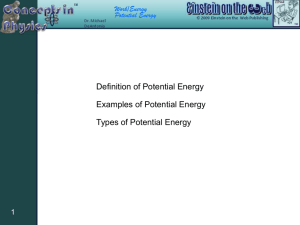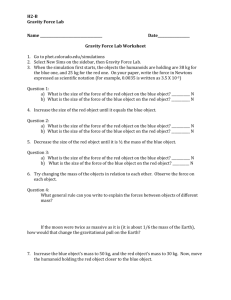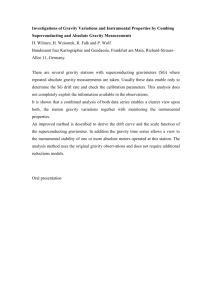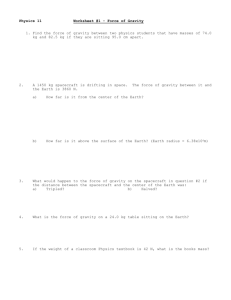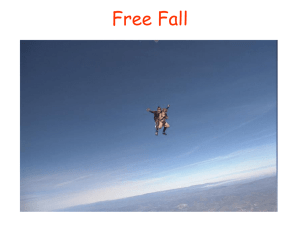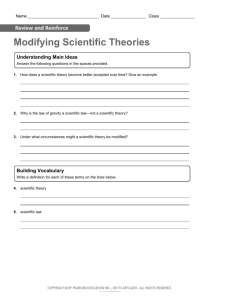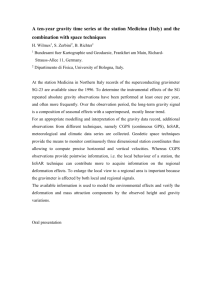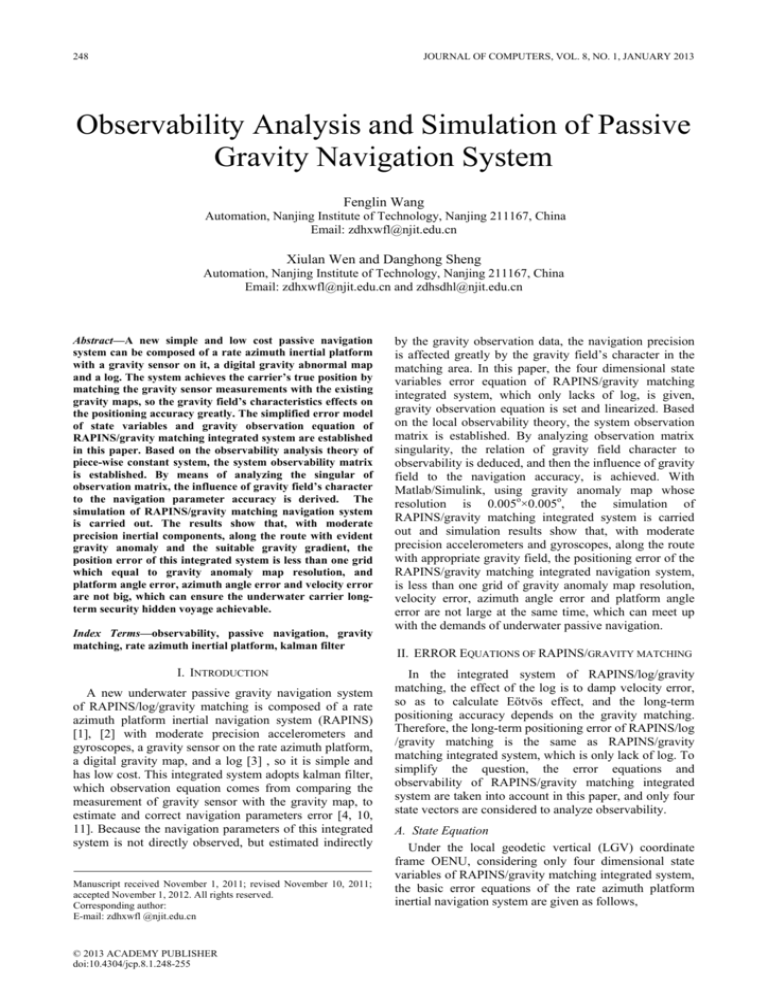
248
JOURNAL OF COMPUTERS, VOL. 8, NO. 1, JANUARY 2013
Observability Analysis and Simulation of Passive
Gravity Navigation System
Fenglin Wang
Automation, Nanjing Institute of Technology, Nanjing 211167, China
Email: zdhxwfl@njit.edu.cn
Xiulan Wen and Danghong Sheng
Automation, Nanjing Institute of Technology, Nanjing 211167, China
Email: zdhxwfl@njit.edu.cn and zdhsdhl@njit.edu.cn
Abstract—A new simple and low cost passive navigation
system can be composed of a rate azimuth inertial platform
with a gravity sensor on it, a digital gravity abnormal map
and a log. The system achieves the carrier’s true position by
matching the gravity sensor measurements with the existing
gravity maps, so the gravity field’s characteristics effects on
the positioning accuracy greatly. The simplified error model
of state variables and gravity observation equation of
RAPINS/gravity matching integrated system are established
in this paper. Based on the observability analysis theory of
piece-wise constant system, the system observability matrix
is established. By means of analyzing the singular of
observation matrix, the influence of gravity field’s character
to the navigation parameter accuracy is derived. The
simulation of RAPINS/gravity matching navigation system
is carried out. The results show that, with moderate
precision inertial components, along the route with evident
gravity anomaly and the suitable gravity gradient, the
position error of this integrated system is less than one grid
which equal to gravity anomaly map resolution, and
platform angle error, azimuth angle error and velocity error
are not big, which can ensure the underwater carrier longterm security hidden voyage achievable.
Index Terms—observability, passive navigation, gravity
matching, rate azimuth inertial platform, kalman filter
I. INTRODUCTION
A new underwater passive gravity navigation system
of RAPINS/log/gravity matching is composed of a rate
azimuth platform inertial navigation system (RAPINS)
[1], [2] with moderate precision accelerometers and
gyroscopes, a gravity sensor on the rate azimuth platform,
a digital gravity map, and a log [3] , so it is simple and
has low cost. This integrated system adopts kalman filter,
which observation equation comes from comparing the
measurement of gravity sensor with the gravity map, to
estimate and correct navigation parameters error [4, 10,
11]. Because the navigation parameters of this integrated
system is not directly observed, but estimated indirectly
Manuscript received November 1, 2011; revised November 10, 2011;
accepted November 1, 2012. All rights reserved.
Corresponding author:
E-mail: zdhxwfl @njit.edu.cn
© 2013 ACADEMY PUBLISHER
doi:10.4304/jcp.8.1.248-255
by the gravity observation data, the navigation precision
is affected greatly by the gravity field’s character in the
matching area. In this paper, the four dimensional state
variables error equation of RAPINS/gravity matching
integrated system, which only lacks of log, is given,
gravity observation equation is set and linearized. Based
on the local observability theory, the system observation
matrix is established. By analyzing observation matrix
singularity, the relation of gravity field character to
observability is deduced, and then the influence of gravity
field to the navigation accuracy, is achieved. With
Matlab/Simulink, using gravity anomaly map whose
resolution is 0.005o×0.005o, the simulation of
RAPINS/gravity matching integrated system is carried
out and simulation results show that, with moderate
precision accelerometers and gyroscopes, along the route
with appropriate gravity field, the positioning error of the
RAPINS/gravity matching integrated navigation system,
is less than one grid of gravity anomaly map resolution,
velocity error, azimuth angle error and platform angle
error are not large at the same time, which can meet up
with the demands of underwater passive navigation.
II. ERROR EQUATIONS OF RAPINS/GRAVITY MATCHING
In the integrated system of RAPINS/log/gravity
matching, the effect of the log is to damp velocity error,
so as to calculate Eötvös effect, and the long-term
positioning accuracy depends on the gravity matching.
Therefore, the long-term positioning error of RAPINS/log
/gravity matching is the same as RAPINS/gravity
matching integrated system, which is only lack of log. To
simplify the question, the error equations and
observability of RAPINS/gravity matching integrated
system are taken into account in this paper, and only four
state vectors are considered to analyze observability.
A. State Equation
Under the local geodetic vertical (LGV) coordinate
frame OENU, considering only four dimensional state
variables of RAPINS/gravity matching integrated system,
the basic error equations of the rate azimuth platform
inertial navigation system are given as follows,
JOURNAL OF COMPUTERS, VOL. 8, NO. 1, JANUARY 2013
⎧ & 1
⎪δ ϕ = R δ V N
⎪
1
sin ϕ V E
⎪δ λ& =
.
δVE +
⎨
R cos ϕ
R (cos ϕ ) 2 δϕ
⎪
⎪δ V&E = wve
⎪ &
⎩δ V N = wvn
249
(1)
~
~
g (ϕ~, λ ) = gb (ϕ~ ) + g y (ϕ~, λ ) .
Where ϕ is the geodetic latitude, λ is the geodetic
longitude, V E is east velocity, V N is north velocity, R is
radius of the earth. w ve is east velocity random noise, and
w vn is north noise.
When X (t ) = [δϕ δλ δV E δV N ]T , the state equation is
described as,
X& = FX + W .
(2)
Where F = [ f ij ] 4 × 4 , the nonzero elements of F
are
f14 =
1 ,
R
1
sin ϕ V E
, f 23 =
,
2
R cos ϕ
R (cos ϕ )
w vn ] T . Because the observation
f 21 =
and W = [ 0 0 w ve
period of gravimeter is 60 seconds, the advisable kalman
filter period cycle ΔT of RAPINS/gravity matching
system is 60 seconds. The discrete the state equation is,
X k= φk / k −1 X k −1+W k −1 .
Where
Where a0 = 9.7803267715 , a1 = 0.001931851353 ,
a2 = 0.0066943800229 .
Then, the calculated gravity of the position (ϕ~, λ~ ) is,
(3)
In the dynamic gravity measurement, the gravity
sensor outputs value g I (ϕ , λ ) can be given as,
g I (ϕ , λ ) = g (ϕ , λ ) − E + rga .
Using A
k −1
dynamic gravity measurement.
Comparing the measurement value g I (ϕ, λ) from
gravity sensor with the calculated gravity value g (ϕ~, λ~ )
from the abnormal gravity map, the observation equation
of RAPINS/gravity matching integrated system can be
obtained as follows,
~
(8)
Z g = g (ϕ~, λ ) − EC − g I (ϕ , λ ) .
(
⎡ 1 ⎤ , the state
⎡ sin ϕ V E ⎤ ,
Bk −1 = ⎢
=⎢
⎥
2 ⎥
R
(cos
ϕ
)
⎣ R cosϕ ⎦ k −1
⎣
⎦ k −1
transferring matrix can be given as,
⎤
⎥
1 Bk −1ΔT (2 R) Ak −1ΔT ⎥ .
⎥
0
1
0
⎥
0
0
1
⎦⎥
0
0
R−1ΔT
−1
2
(4)
B. Observational Equation
The rate azimuth platform inertial navigation system is
independent; it can provide general navigation parameter,
which includes calculated position parameter (ϕ~, λ~ ) . With
the digital abnormal gravity map, the abnormal gravity
~
~
can be achieved.
g y (ϕ~, λ ) of the position (ϕ~, λ )
According to WGS84 reference ellipsoid surface standard
gravity equation provided by U.S. defense SMC, g b (ϕ~ )
of the position (ϕ~, λ~ ) can be calculated as,
g b (ϕ~ ) = a0 (1 + a1 sin 2 ϕ~ ) × (1 − a2 sin 2 ϕ~ ) −0.5 .
© 2013 ACADEMY PUBLISHER
)
Where E C is the calculated Eötvös effect, which is
worked out by the parameter provide by the rate azimuth
platform inertial navigation system. Regarding (6) and (7),
the observation equation is described as,
~
Zg=[g(ϕ~,λ) −g(ϕ,λ)]−rE −rga.
( FΔT ) 2 ( FΔT ) 3 .
+
2!
3!
⎡ 1
⎢
A ΔT
φk / k −1 = ⎢ k −1
⎢ 0
⎢
⎣⎢ 0
(7)
Where (ϕ , λ ) is the true position of its carrier. g(ϕ, λ) is
the static gravity value. E is Eötvös effect, which is
produced owing to velocity, r ga is the other error in
φk / k −1 is the state transferring matrix, and,
φ k / k −1 = I + F Δ T +
(6)
(9)
Where rE is the Eötvös effect calculation error,
which is small if log is considered. To study the relation
of gravity field to gravity matching, the influence of
Eötvös effect calculation error is neglected. Linearizing
the observation equation of (9), then,
⎡δϕ ⎤
⎢ ⎥
.
(10)
⎡ ∂g(ϕ, λ) ∂g(ϕ, λ)
⎤ δλ
Z =⎢
0 0⎥ ⎢ ⎥ + r
⎥
⎢
δ
V
ϕ
λ
∂
∂
⎣
⎦
E
⎢ ⎥
δ
V
⎣ N⎦
Where ∂g (ϕ , λ ) and ∂g (ϕ , λ ) are gravity gradient in
∂λ
∂ϕ
the latitude and the longitude direction severally, and r
is the sum of the Eötvös effect calculation error, gravity
sensor noise, gravity anomaly map noise and linear error.
Then, the observation matrix H is,
⎡ ∂ g (ϕ , λ )
H =⎢
⎣ ∂ϕ
In
view
of
∂ g (ϕ , λ )
∂λ
0
⎤
0⎥
⎦
T
.
(11)
g (ϕ, λ ) = g y (ϕ, λ ) + g b (ϕ ) ,
observation matrix H can also be described as,
(5)
⎡ ∂g (ϕ , λ )
H =⎢
⎣ ∂ϕ
∂g y (ϕ , λ )
∂λ
T
⎤
0 0⎥ .
⎦
the
250
JOURNAL OF COMPUTERS, VOL. 8, NO. 1, JANUARY 2013
III. OBSERVABILITY OF RAPINS/GRAVITY MATCHING
On the basis of state transition matrix
φk / k −1
and the
observation matrix H k , the local observable matrix [5], [6]
M is inferred as,
⎤
⎡H k
⎥
⎢H φ
⎥
⎢ k +1 k +1/ k
⎥.
M = ⎢ H k +2φk +2 / k +1φk +1/ k
⎥
⎢
⎥
⎢M
⎢ H k +n−1φk +n−2 / k +n−1 Kφk +1/ k ⎥
⎦
⎣
If the rank of the local observable matrix M is n, the
integrated navigation system is locally observable in the
time from k to k + n − 1 [7], [8].
A. Observability of Four Dimensional State Variabl
In view of (4) and (11), to four dimensional state
variables X (t) = [δϕ δλ δVE δVN ]T , the locally observable
matrix M 4×4 is as follows,
M
1 ,1
=
∂g
( k ),
∂ϕ
M 2 ,1 =
∂g
∂g
( k + 1) +
( k + 1) × A k Δ T ,
∂λ
∂ϕ
∂g
∂g
( k + 2) +
( k + 2) × ( Ak +1 + Ak ) ΔT ,
∂ϕ
∂λ
∂g
∂g
M 4,1 =
(k + 3) +
(k + 3) × ( Ak + 2 + Ak +1 + Ak )ΔT ,
∂ϕ
∂λ
∂g
∂g
∂g
M 1, 2 =
(k ), M 2 , 2 =
( k + 1),
M 3 , 2=
( k + 2 ),
∂λ
∂λ
∂λ
∂g
M1,3 = 0, M 2 , 3 = ∂ g ( k + 1) × B k Δ T ,
M 4, 2 =
(k + 3),
∂λ
∂λ
M 3,1 =
M 3,3 =
∂g
( k + 2 ) × ( B k +1 + B k ) Δ T ,
∂λ
∂g
M1,4 = 0,
M 4,3 =
(k + 3) × ( Bk + 2 + Bk +1 + Bk )ΔT ,
∂λ
∂g
1
∂g
1
M 2,4 =
( k + 1) × Δ T +
( k + 1) × Ak ×
ΔT 2 ,
∂ϕ
R
∂λ
2R
∂g
2
∂g
1
M 3,4 =
(k + 2) × ΔT + (k + 2) × (3 Ak +1 + Ak ) ×
ΔT 2 ,
R
∂ϕ
∂λ
2R
3
∂g
1
∂g
M4,4 = (k + 3) × ΔT + (k + 3) × (5Ak+2 + 3Ak+1 + Ak ) × ΔT2 .
R
∂ϕ
∂λ
2R
ΔT is 60 seconds. The absolute value of Ak −1 and Bk −1
are increased along with the increase of latitude. When
latitude increases from 0 o to 60 o, Ak −1 will increase from
0 to 3.3983× 10−8 , and Bk −1 will increase from R −1 to 2R−1 .
It can be seen that the fourth column of matrix M 4×4 is far
less than that of the first column, and the third column of
M is far less than the second column. So M is close to
singular matrix, and the four dimension state variables
can’t be estimated very well at the same time.
For more understandably analyzing the singularity of
matrix M 4×4 , given that the carrier sails along north, so
ϕ is constant all the time, that is VE = 0 , then Ak = 0 , Bk
© 2013 ACADEMY PUBLISHER
is a constant value. Using Bk = B , matrix M 4×4 is
simplified as follows,
∂g y
⎤
⎡ ∂g
(k)
(k)
0
0
⎥
⎢
ϕ
λ
∂
∂
⎥
⎢
∂g y
∂g y
ΔT ∂g
⎥
⎢ ∂g
(k + 1) ⎥
⎢ ∂ϕ (k + 1) ∂λ (k + 1) BΔT ∂λ (k + 1)
R ∂ϕ
M4×4 = ⎢
⎥
⎢ ∂g (k + 2) ∂g y (k + 2) 2BΔT ∂g y (k + 2) 2 ΔT ∂g (k + 2)⎥
⎥
⎢∂ϕ
R ∂ϕ
∂λ
∂λ
⎥
⎢ ∂g
∂g y
∂g y
ΔT ∂g
⎢ (k + 3)
(k + 3) 3BΔT
(k + 3) 3
(k + 3) ⎥
R ∂ϕ
∂λ
∂λ
⎦⎥
⎣⎢ ∂ϕ
It can be seen that when latitude
ϕ
00
varies from
0
to 60 , M (:, 4 ) ≤ 3 × 10 −5 M (:,1) , and M (:,3) ≤ 6 ×10−5 M (:,2) .
Therefore, the locally observable matrix M 4×4 is almost a
singular matrix, and the four dimensional state variable
T
X (t ) = [δϕ δλ δVE δVN ] have bad observability. Because
the velocity error δ V E and δV N is not directly in
observation equation of (10), but indirectly observed by
the system matrix coupled to the state variables δϕ
and δλ . Then the observability of δ V E and δV N is
relatively bad, which means the velocity error of
RAPINS/gravity matching integrated system is relatively
large.
B. Observability of Two Dimensional State Variables
If only two dimensional state variables
δϕ
and
δλ
are considered, then X (t ) = [δϕ δλ ] , the derivation of
corresponding locally observable matrix M 2×2 is as
follows,
T
M 2×2
∂g
⎡
(k )
⎢
∂ϕ
=⎢
⎢ ∂g (k + 1) + ∂g (k + 1) × Ak ΔT
⎢⎣ ∂ϕ
∂λ
∂g
⎤
(k ) ⎥
.
∂λ
⎥
∂g
(k + 1)⎥
⎥⎦
∂λ
When latitude is less than 60 o, Ak ≤ 3.3983 × 10 −8 , so
∂g
Ak ΔT ×
(k + 1) can be ignored generally. The
∂λ
observability of the integrated system is entirely
depended on the gravity gradient ∂ g ( k ) and ∂ g (k ) .
∂λ
∂ϕ
According to the singularity of matrix M 2×2 , some
conclusions are obtained,
(1) To acquire better observability, the gravity gradient
of ∂ g ( k ) and ∂ g (k ) should not be too small,
∂λ
∂ϕ
which means the gravity character is obvious. If
∂g
∂g
(k ) are close to zero, M 2×2 is
( k ) and
∂λ
∂ϕ
nearly a singular matrix.
(2) To acquire better observation, ∂ g ( k ) and ∂ g (k )
∂λ
∂ϕ
should not differ too much. In the general area of the
JOURNAL OF COMPUTERS, VOL. 8, NO. 1, JANUARY 2013
251
earth, the gravity contour varies greatly in latitude
direction, and gently in longitude direction, which
means that ∂ g ( k ) is far greater than ∂ g (k )
∂λ
∂ϕ
generally, so the first column of matrix M 2×2 is much
greater than the second column, thus M 2×2 is close
to singular, then ϕ is observable,
unobservable, and the estimated parameter
λ
ϕ
is
has
higher precision than λ . In the special area, which
gravity anomaly vary significantly, ∂ g ( k ) and
∂ϕ
∂g
( k ) are big at the same time, so the estimated
∂λ
parameter ϕ and
λ
both have high precision.
(3) To acquire better observation, ∂ g ( k ) and
∂ϕ
∂g
must
vary
drastically
along
with k. If
(k )
∂λ
∂g
∂g
∂g
(k + 1) is close to
( k + 1) close to
(k ) , or
∂λ
∂ϕ
∂ϕ
∂g
( k ) , M 2×2 is nearly singular. When they vary
∂λ
more greatly, matrix M 2×2 has more nonsingular, so
ϕ and λ have better observability.
(4) To acquire better observability, ∂ g ( k ) and ∂g (k )
∂λ
∂ϕ
can't vary with the same rules as k. If
∂g
∂g
∂g
∂g
( k + 1) /
(k ) ,
( k + 1) /
( k ) is the same as
λ
∂
λ
∂
∂ϕ
∂ϕ
M 2×2 is singular.
IV. SIMULATION OF RAPINS/GRAVITY MATCHING
With Matlab/Simulink tools, the simulation of the
RAPINS/gravity matching integrated navigation system
is carried out. The simulation block diagram is shown as
Fig. 1.
Based on true navigation parameter provided by ideal
rate azimuth platform inertial navigation system, which
includes the true location (ϕ , λ ) and true velocity
(VE ,VN ) of the carrier, the true Eötvös effect E and
standard gravity g b (ϕ ) can be obtained. With digital
gravity abnormal map, gy (ϕ, λ) also can be found. The
true static gravity g (ϕ , λ ) is the sum of gy (ϕ, λ)
and g b (ϕ ) . After g (ϕ, λ) subtracting E , plusing other
interference rga , gravity sensor output g I (ϕ , λ ) can be
simulated.
Adding inertial components error, installation error,
initial error and other noise to ideal rate azimuth platform
system, the actual rate azimuth platform inertial
navigation system can be simulated, which outputs
calculated location parameter ( ϕ~ , λ~ ) , velocity parameter
~ ~
(VE , VN ) , platform angle error (φ x , φ y , φU ) and others.
Based on these calculated parameters, Eötvös effect is
calculated as E C , standard gravity is calculated as gb (ϕ~) ,
~
and gravity abnormal value can also be found as g y (ϕ~, λ )
with digital gravity abnormal map. Adding gb (ϕ~) to
~
~~
g y (ϕ~, λ ) , the calculated static gravity g(ϕ, λ ) is formed.
~
After g(ϕ~, λ ) subtracting E , and subtracting g (ϕ , λ ) ,
C
I
the observation value Z g of kalman filter is gained.
GARL refers to gravity anomaly random linearity
technology, which is used to calculate gravity gradient
∂g (ϕ , λ )
∂g (ϕ , λ )
( k ) . To simplify question, EC
( k ) and
∂λ
∂ϕ
is supposed the same as E in this paper, so as to
conveniently analyze the influence of gravity field to
navigation precision.
RAPINS/gravity matching integrated system adopts
kalman filter to estimate navigation parameter errors. The
state equation of kalman filter is consisted of rate
azimuth platform system’s platform angle error equations,
azimuth angle error equation, velocity error equations,
position error equations, and the error models of
gyroscope drifts and accelerometer drifts [9], which is,
X& (t ) = F (t ) X (t ) + G (t )W (t ) .
(12)
Where the system state vector X (t) = [φx ,φy ,φU , ΔVE , ΔVN
ΔVU , Δϕ , Δλ , Δh, ε x , ε y , ε z , ΔAx , ΔAy , ΔAz ] . φ x and φ y are
platform angle error, φU is azimuth angle error,
and
εz
are
εx ,εy
gyroscope drifts, ΔAx , ΔAy and ΔAz are
accelerometer drifts. The state transferring matrix F(t) ,
noise matrix G(t) and noise vector W (t ) are all obtained
by state error equations, which are the same as in [9].
On basis of (9), the observation equation of
RAPINS/gravity matching integrated system can be
shown as,
Figure1. Simulation block diagram of RAPINS/gravity matching
© 2013 ACADEMY PUBLISHER
Z (t ) = H (t ) X (t ) + V (t ) .
(13)
252
JOURNAL OF COMPUTERS, VOL. 8, NO. 1, JANUARY 2013
Where H (t ) = [ h ]1×15 , observation noise V (t ) and
W (t ) are all be confirmed by the parameters of navigation
initial error, instrument error and other error.
φk / k −1
is state transition matrix from time k-1 to k,
Γk / k −1 is system noise transformation matrix from time
k-1 to k, W k −1 is system noise, Vk is observation noise.
W k and Vk are irrelevant zero mean white noise
sequences, and,
E {W kW j } = Q k δ kj
(18)
E {V k V j } = R k δ kj
(19)
Based on the state transformation matrix F (t ) in
equation (12), the discretized state transformation matrix
φk / k −1 can be calculated as,
Figure 2. Nine dots method fitting abnormal gravity field
nonzero
elements
of
are,
H(t)
~
~
~
~
∂g (ϕ , λ ) ,
∂ g (ϕ , λ ) , which can be
[h]1,7 =
[ h ]1,8 =
∂λ
∂ϕ
calculated by abnormal gravity random linearity
technology and differential of standard gravity equation
(5). Nine dots fitting method is used to calculate gravity
~
~
∂g y (ϕ~, λ )
∂g y (ϕ~, λ )
in this
and
abnormal gradient
∂λ
∂ϕ
simulation. As shown in Fig. 2, it selects the dot on the
grid, which is the nearest to the integrated system output
position (ϕ~, λ~ ) , as the center, and selects other nearby
eight dots on the gravity abnormal grid, σ ϕ and σ λ are
φk / k −1 = e F (t
The
obtained by state mean square matrix P of kalman filter.
In the fitting area confirmed by the nine grid dots, least
square method is used to calculate the plane fitting for
~
the gravity abnormal curve g y (ϕ~, λ ) , which is
determined by this nine grid dots. Using g yi as the
abnormal gravity of point i, gravity abnormal gradient of
the fitting plane is calculated as,
~
∂g y (ϕ~, λ ) ( g y1 + g y 2 + g y3 ) − ( g y7 + g y8 + g y9 )
(14)
=
6Md
∂ϕ
~
∂gy (ϕ~, λ) (gy3 + gy6 + gy9) −(gy1 + gy4 + gy7 )
=
6Nd
∂λ
(15)
In the RAPINS/gravity matching integrated navigation
system, the state updated frequency of rate azimuth
platform inertial navigation system can is assumed as 0.1
second, the observation cycle of gravity sensor is
assumed as 60 seconds, so the sampling period Δt of
kalman filter can be set as o.1 second, the filter cycle
ΔT can be set as 60 seconds. The discretized state
equation and observation equation can be described as,
X k= φk / k −1 X k −1+Γk / k −1W k −1
Z k = H k X k −1 + Vk .
(16)
(17)
Where X k is the 15 dimensional state vector of time k,
Z k is one dimensional observation vector of time k,
© 2013 ACADEMY PUBLISHER
n
)T
∞
=∑
(F (tk )T )n
n =0
n!
(20)
Where T is the state updated calculation cycle, n can
choose bigger when filter cycle is short, and choose
smaller when filer cycle is long. In the later kalman filter
recursive equation, state prediction equation Xˆ k / k −1 and
mean square error equation Pk / k −1 are both needed to
calculate
cycle T
φk / k −1 . When calculating Pk / k −1 ,
of φk / k −1 in equation (20) can use
the updated
0.1 second,
which is the same as the state updated frequency of rate
azimuth platform inertial navigation system, and n can
use 3. When calculating Xˆ k / k −1 , the updated cycle T of
φk / k −1
in equation (20) can use 60 seconds, which is the
same as the observation cycle of gravity sensor, and n can
use 5.
Based on the state transformation matrix G (t ) in
equation (12), the discretized noise transformation
matrix Γk / k −1 can be calculated as,
Γk / k −1 = φk / k −1G (tk −1 )Δt
(21)
The discretized state noise matrix Qk and observation
noise matrix Rk can be calculated as,
Q (t k )
(22)
Δt
R (t k )
(23)
Rk =
ΔT
The standard closed loop kalman filter recursive
equation is as follows,
(1) Step mean square error predicted equation
Qk =
Pk / k−1 = φk / k−1Pk−1φkT/ k−1 + Γk / k−1Qk−1ΓkT/ k−1
(24)
(2) Filter gaining equation
Kk = Pk / k−1HkT (Hk Pk / k−1HkT + Rk )−1
(25)
(3) Estimated mean square error equation
Pk = (1− Kk Hk )Pk / k−1
(4) State step prediction equation
(26)
JOURNAL OF COMPUTERS, VOL. 8, NO. 1, JANUARY 2013
Xˆ k / k−1 = φk / k−1 Xˆ k−1
253
(27)
(5) State estimation calculation equation with close loop
controlling method
(28)
Xˆ k = Kk Zk
After the closed loop kalman filter recursive equation
is performed, the navigation parameter, such as position
error, velocity error, and platform angle error are all
evaluated, and these errors are used to correct the
parameter of pure rate azimuth platform inertial
navigation system to improve navigation precision, which
is called integrated navigation parameter precision.
Subtracting the integrated navigation parameter with the
ideal navigation parameter, the navigation errors of
RAPINS/gravity matching integrated system are obtained.
The carrier with RAPINS/gravity matching integrated
system has initial conditions and model parameters as
follows, rate azimuth platform system initial horizontal
attitude (pitch and roll) error angles is 45″, initial azimuth
error angle 2’, initial position error 50m, velocity error
0.3m/s, integrated gyro bias drift and random walk are
0.01°/h and 0.005°/h, rate gyro bias drift and random
walk are 0.05°/h and 0.03°/h respectively, three
accelerometers bias drift is 50 μg, the gravity sensor
noise is 0.05mGal, and the Eötvös effect calculation error
is ignored. The digital gravity anomaly map with grid
resolution of 0.005o ×0.005o is adopted. Fig. 3 is the
gravity anomaly contour of matching area from the
region of (138o,15o) to (146o,27o).
Figure 5. The curve of positioning error
Fig.4 is the corresponding gravity contour. In this
region, the gravity contour is dense, and gravity character
is obvious. The unit of colorbar is m/s2 in Fig.3 and Fig.4.
When the carrier sails toward the north from position
(16 0 , 142.50 ) at a constant speed of 20 m/s, the
positioning error curve of RAPINS/gravity matching
integrated navigation system in the process of 16 hours
sailing is shown in Fig. 5.
The horizontal axis of Fig. 5 is the carrier’s latitude,
longitude is 142.50 all the time. The vertical axis is the
navigation positioning error. In this figure, it can be
shown that RAPINS/gravity matching integrated system
has different positioning accuracy along different region.
To study the relation of gravity field to position
precision obviously, the gravity gradient curve in the
process of navigation, which is calculated by using (14) ,
(15) and differential of equation (5) , is shown in Fig. 6.
Figure3. Gravity anomaly contour of matching area
Figure 6. The curve of gravity gradient
Figure 4. Gravity contour of matching area
© 2013 ACADEMY PUBLISHER
From Fig. 6 , it can be seen that, along the route from
(142.5 o,16.2 o) to (142.5 o,19.2 o), the gravity gradient
curve is gentle, that is ∂ g ( k ) and ∂ g ( k ) vary very
∂λ
∂ϕ
g
∂
slowly, which means
( k + 1) is close to ∂ g (k ) ,
∂ϕ
∂ϕ
∂g
(k + 1) is close to ∂ g ( k ) , which leads to M 2×2 close
∂λ
∂λ
to singularity. At the same time, in this region, ∂ g ( k )
∂ϕ
varies mostly according to the same regularity as
254
∂g
∂g
∂g
( k ) , which means
( k + 1) /
( k ) is the same as
∂λ
∂ϕ
∂ϕ
∂g
∂g
( k + 1) /
( k ) . So the observability of matrix M 2×2
∂λ
∂λ
JOURNAL OF COMPUTERS, VOL. 8, NO. 1, JANUARY 2013
is shown in Fig. 7, and the velocity errors in east and
north are both less than 0.4m/s in most navigation area.
is almost singular in this region. Because of these two
reasons, the observability is bad, then the navigation
positioning error is very large. This can be proved from
Fig. 4, which shows Δϕ is up to 2.5 times the grid, and
Δλ is nearly up to 4 times the grid. Because the curve of
∂g
∂g
( k ) is gentler than
( k ) in this region, so the
∂λ
∂ϕ
observation of latitude is more bad than longitude, and
Δλ is bigger than Δϕ .
At the same time, Fig. 6 shows that, along the route
from (142.5 o,19.2 o) to (142.5 o,26.2 o), the gravity
gradient curve is violent ups and downs, which means
∂g
∂g
(k ) vary very quickly, ∂g ( k + 1)
( k ) and
∂λ
∂ϕ
∂ϕ
differs greatly with ∂ g (k ) , ∂g (k + 1) differs greatly
∂λ
∂ϕ
with ∂ g ( k ) , which is advantage to M 2×2 nonsingularity.
∂λ
What’s more, in this region, ∂ g (k ) varies much
∂ϕ
g
∂
differently from
(k ) , which means ∂g (k + 1) / ∂g (k ) is
∂λ
∂ϕ
∂ϕ
very unequal to ∂ g ( k + 1) / ∂ g ( k ) . So the observation
∂λ
∂λ
matrix M 2×2 is nonsingular in this region, and the
observability is good, then the navigation positioning
error is very small. This can be testified by Fig. 5, it
shows Δϕ and Δλ is nearly within one grid, which is
just the resolution of gravity anomaly map.
Furthermore, because the longitude λ is only related
to anomaly gravity, then ∂ g (k ) is very small in most
∂λ
matching region on the earth owing to unapparent gravity
anomaly. At the same time, the longitude ϕ is the
function of anomaly gravity and standard gravity,
∂g
( k ) is relatively big in most matching region,
∂ϕ
∂g
∂g
(k ) differs greatly on the earth
( k ) and
∂
λ
∂ϕ
generally. Then, in most navigation area, the longitude λ
is unobservable, and the longitude error Δλ is very big.
Meanwhile, the longitude ϕ is observable, and the
longitude error Δ ϕ is very small. This can be proved by
many other simulations along different routes. Because
positioning accuracy is significantly different with the
matching area of variant gravity field, so it is very
important to search suitable navigation route for
RAPINS/gravity matching integrated navigation system.
In addition, the corresponding velocity error curve of
RAPINS/gravity matching integrated navigation system
© 2013 ACADEMY PUBLISHER
Figure 7. The curve of velocity error
It can be seen that, along the bad position matching
route from (142.5 o,16.2 o) to (142.5 o,19.2 o), the
integrated navigation system nearly has the equal
velocity error as along the well position matching route
from (142.5 o,19.2 o) to (142.5 o,26.2 o), which means the
velocity error is not affected by matching region very
much. This is because matrix M 4×4 is singular, and the
velocity error has bad observablility.
Figure 8. The curve of azimuth angle error
Figure 9. The curve of horizontal attitude angles error
The azimuth angle error of RAPINS/gravity matching
integrated navigation system is shown in Fig. 8, which is
mostly less than 2.5' . The horizontal attitude angles error,
JOURNAL OF COMPUTERS, VOL. 8, NO. 1, JANUARY 2013
referring to pitch f
255
''
x
and roll f y , is usually less than 1 ,
which is shown in Fig. 9.
[8]
V. SUMMARY
The integrated navigation system of RAPINS/gravity
matching corrects positioning error real time by
measuring gravity indirectly, so the positioning precision
is relevant to gravity field of matching area. Based on the
local observability theory, the relationship between
observability and the character of gravity field is
analysized in this paper, which mainly points out that, to
acquire better observability, the gravity gradient in
latitude direction and longitude direction should not be
too small, should not differ too much, must vary
drastically along with time, and they can't change
according to the same rules with time. The simulation
results show that, along the route with suitable gravity
field which meets the requirements of observation matrix
nonsingularity, the integrated system of RAPINS/gravity
matching has good navigation accuracy, positioning error
is less than one grid, velocity error, platform angle error
and azimuth angle error are not big at the same time,
which can meet up with the demands of underwater
passive gravity navigation.
ACKNOWLEDGMENT
This project is supported by Natural Science Research
Project of the People’s Republic of China (No:
51075198), Natural Science Research Project of Jiangsu
Province (BK2010479) and Innovation Research of
Nanjing Institute of Technology (CKJ20100008).
REFERENCES
[1] Cai Tijing, G. I.Emeliantsev, “Study on rate azimuth
platform inertial navigation system”, Journal of Southeast
University (English Edition), vol. 121, no.1, pp. 29–32,
2005.
[2] WANG Feng-in, Wen Xiulan, Lin Jian, “Federated
Kalman filter for rate azimuth inertial platform / log
/gravity matching integrated navigation system”, Journal of
Southeast University, vol.39, pp.49-54, 2009. (in Chinese)
[3] ZHANG Tao,XU Xiao-su, “Azimuth strapdown inertial
navigation Platform system and error analysis[”, Journal of
Chinese Inertial Technology, vol.14, no.5, pp.5–8, 2006.
(in Chinese)
[4] Zhu Yanhua, Cai Tijing, Lu Zhen, “The Simulation
Research on SINS/Log/Gravity Passive Integrated
Navigation System”, Journal of Projectiles, Rockets,
Missiles and Guidance, vol.31, no.4, pp. 5-7, Aug 2011.
(in Chinese)
[5] WANG Chao, ZHU Hai, GAO Dayuan, WU Zifei,
“Observability analysis of rotation of strapdown inertial
navigation system”, Journal of Dalian Maritime University,
vol.36, no.4, pp.23-26, 2010. (in Chinese)
[6] HU Xiao-mao, LIU Fei, WENG Hai-na, “Observability
analysis of MSINS/GPS complete integrated system”,
Journal of Chinese Inertial Technology, vol.19, no.1,
pp.38-45, Feb.2011. (in Chinese)
[7] YANG Jian-xiong, LI Mao-qin, “Modified Structural
Decomposition for Linear Singular Systems and Its
Properties of Controllability and Observability”, Journal of
© 2013 ACADEMY PUBLISHER
[9]
[10]
[11]
Xiamen University (in chinese), vol.47, no.3, pp.337-342,
May 2008. (in Chinese)
Deng Xinpu, Wang Qiang, Zhong Danxing, “Observability
of Airborne Passive Location System with Phase
Difference
Measurements”,
Chinese
Journal
of
Aeronautics, vol.21, pp.149-154, 2008. (in Chinese)
WANG Feng-lin, CAI Ti-jing, LU Yong, “Research on
GPS/Rate Azimuth Inertial Integrated Navigation System”,
Journal of System Simulation, vol.20, no.13, pp.3348-3350,
2008. (in Chinese)
Rongbo Zhu, “Intelligent Rate Control for Supporting
Real-time Traffic in WLAN Mesh Networks,” Journal of
Network and Computer Applications, vol. 34, no. 5, pp.
1449-1458, 2011.
Rongbo Zhu, Yingying Qin and Chin-Feng Lai, “Adaptive
Packet Scheduling Scheme to Support Real-time Traffic in
WLAN Mesh Networks,” KSII Transactions on Internet
and Information Systems, vol. 5, no. 9, pp. 1492-1512,
2011.
Fenglin Wang received the MEng and
PhD in measurement technology and
instruments from Southeast University,
Nanjing, China, in 2003 and 2006
respectively, received Bachelor in
industrial automation from Wuhan
University of Hydraulic and Electric
Engineering.
She is currently an associate professor of
mechanical engineering in the automation
department of Nanjing Institute of Technology. She is mainly
engaged in integrated navigation, information fusion, precision
measuring technology research, and acts as the first author of
nearly twenty technical papers in these areas.

